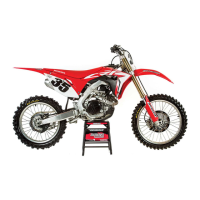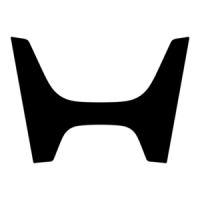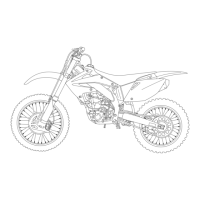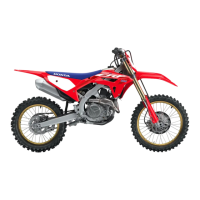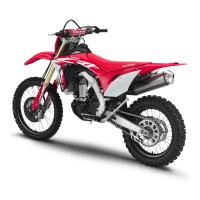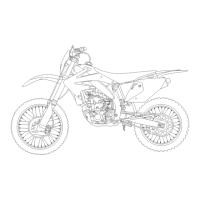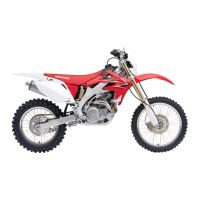Coolant
58 Servicing Your Honda
Coolant
Your CRF’s liquid cooling system dissipates
engine heat through the coolant jacket that
surrounds the cylinder and cylinder head.
Maintaining the coolant will allow the cooling
system to work properly and prevent freezing,
overheating, and corrosion.
Use high quality ethylene glycol antifreeze
containing corrosion protection inhibitors
specifically recommended for use in aluminum
engines. Check the antifreeze container label.
Use only distilled water as a part of the coolant
solution. Water that is high in mineral content or
salt may be harmful to the aluminum engine.
Using coolant with silicate inhibitors may cause
premature wear of the mechanical seal or
blockage of the radiator passages. Using tap
water may cause engine damage.
The factory provides a 50/50 solution of antifreeze
and water in this motorcycle. This coolant solution
is recommended for most operating temperatures
and provides good corrosion protection.
Decreasing the concentration of antifreeze to less
than 40% will not provide proper corrosion
protection.
Increasing the concentration of antifreeze is not
recommended because it decreases cooling system
performance. Higher concentrations of antifreeze
(up to 60%) should only be used to provide
additional protection against freezing.
Check the cooling system frequently during
freezing weather.
Refer to Safety Precautions on page 27.
1. With the engine cold, remove the radiator cap
(1) and check coolant level. The coolant level
is correct when it is at the bottom of the
radiator filler neck (2).
2. Add coolant up to the filler neck if the level is
low.
Inspect the coolant level before each outing.
A coolant loss of 20 – 60 cm
3
(0.7 – 2.0 US oz,
0.7 – 2.1 Imp oz) through the over flow tube is
normal. If coolant loss is more than this,
inspect the cooling system.
Capacity:
1.06 ℓ (1.12 US qt, 0.93 Imp qt) after
disassembly
1.04 ℓ (1.10 US qt, 0.92 Imp qt) after
draining
3. Install the radiator cap securely.
If the radiator cap is not installed properly, it will
cause excessive coolant loss and may result in
overheating and engine damage.
Coolant Recommendation
Checking & Adding Coolant
Removing the radiator cap while the
engine is hot can cause the coolant to
spray out, seriously scalding you.
Always let the engine and radiator cool
down before removing the radiator cap.
(1) radiator cap
(2) radiator filler neck
CRF450R.book Page 58 Thursday, July 8, 2010 9:34 AM
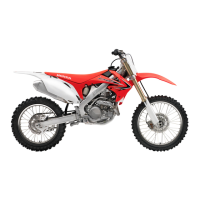
